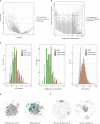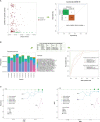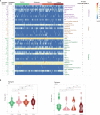T cell receptor β repertoires in patients with COVID-19 reveal disease severity signatures
- PMID: 37475855
- PMCID: PMC10355153
- DOI: 10.3389/fimmu.2023.1190844
T cell receptor β repertoires in patients with COVID-19 reveal disease severity signatures
Abstract
Background: The immune responses to severe acute respiratory syndrome coronavirus 2 (SARS-CoV-2) are crucial in maintaining a delicate balance between protective effects and harmful pathological reactions that drive the progression of coronavirus disease 2019 (COVID-19). T cells play a significant role in adaptive antiviral immune responses, making it valuable to investigate the heterogeneity and diversity of SARS-CoV-2-specific T cell responses in COVID-19 patients with varying disease severity.
Methods: In this study, we employed high-throughput T cell receptor (TCR) β repertoire sequencing to analyze TCR profiles in the peripheral blood of 192 patients with COVID-19, including those with moderate, severe, or critical symptoms, and compared them with 81 healthy controls. We specifically focused on SARS-CoV-2-associated TCR clonotypes.
Results: We observed a decrease in the diversity of TCR clonotypes in COVID-19 patients compared to healthy controls. However, the overall abundance of dominant clones increased with disease severity. Additionally, we identified significant differences in the genomic rearrangement of variable (V), joining (J), and VJ pairings between the patient groups. Furthermore, the SARS-CoV-2-associated TCRs we identified enabled accurate differentiation between COVID-19 patients and healthy controls (AUC > 0.98) and distinguished those with moderate symptoms from those with more severe forms of the disease (AUC > 0.8). These findings suggest that TCR repertoires can serve as informative biomarkers for monitoring COVID-19 progression.
Conclusions: Our study provides valuable insights into TCR repertoire signatures that can be utilized to assess host immunity to COVID-19. These findings have important implications for the use of TCR β repertoires in monitoring disease development and indicating disease severity.
Keywords: T cell receptor β repertoire; T cells; coronavirus disease 2019; immunology; machine learning.
Copyright © 2023 Xu, Li, Yuan, Li, Yang, Cheng, Lu, Hou, Zhang, Hu, Qian, Liu, Li, Wang, Chu, Dong, Liu, Ge and Yang.
Conflict of interest statement
The authors declare that the research was conducted in the absence of any commercial or financial relationships that could be construed as a potential conflict of interest.
Figures






Similar articles
-
Profiling of T Cell Repertoire in SARS-CoV-2-Infected COVID-19 Patients Between Mild Disease and Pneumonia.J Clin Immunol. 2021 Aug;41(6):1131-1145. doi: 10.1007/s10875-021-01045-z. Epub 2021 May 5. J Clin Immunol. 2021. PMID: 33950324 Free PMC article.
-
Analysis of TCR Repertoire by High-Throughput Sequencing Indicates the Feature of T Cell Immune Response after SARS-CoV-2 Infection.Cells. 2021 Dec 27;11(1):68. doi: 10.3390/cells11010068. Cells. 2021. PMID: 35011632 Free PMC article.
-
Identification of TCR repertoires in asymptomatic COVID-19 patients by single-cell T-cell receptor sequencing.Blood Cells Mol Dis. 2022 Nov;97:102678. doi: 10.1016/j.bcmd.2022.102678. Epub 2022 Jun 2. Blood Cells Mol Dis. 2022. PMID: 35716403 Free PMC article.
-
Utility of Bulk T-Cell Receptor Repertoire Sequencing Analysis in Understanding Immune Responses to COVID-19.Diagnostics (Basel). 2022 May 13;12(5):1222. doi: 10.3390/diagnostics12051222. Diagnostics (Basel). 2022. PMID: 35626377 Free PMC article. Review.
-
The characteristics of TCR CDR3 repertoire in COVID-19 patients and SARS-CoV-2 vaccine recipients.Virulence. 2024 Dec;15(1):2421987. doi: 10.1080/21505594.2024.2421987. Epub 2024 Nov 4. Virulence. 2024. PMID: 39468707 Free PMC article. Review.
Cited by
-
Repeated mRNA vaccination sequentially boosts SARS-CoV-2-specific CD8+ T cells in persons with previous COVID-19.Nat Immunol. 2024 Jan;25(1):166-177. doi: 10.1038/s41590-023-01692-x. Epub 2023 Dec 6. Nat Immunol. 2024. PMID: 38057617 Free PMC article.
-
Exploring the Role of CD74 and D-Dopachrome Tautomerase in COVID-19: Insights from Transcriptomic and Serum Analyses.J Clin Med. 2023 Jul 31;12(15):5037. doi: 10.3390/jcm12155037. J Clin Med. 2023. PMID: 37568438 Free PMC article.
-
Temporal TCR dynamics and epitope diversity mark recovery in severe COVID-19 patients.Front Immunol. 2025 Jul 10;16:1582949. doi: 10.3389/fimmu.2025.1582949. eCollection 2025. Front Immunol. 2025. PMID: 40709175 Free PMC article.
-
TCR repertoire dynamics and their responses underscores dengue severity.iScience. 2024 Sep 16;27(10):110983. doi: 10.1016/j.isci.2024.110983. eCollection 2024 Oct 18. iScience. 2024. PMID: 39403197 Free PMC article.
-
Distinctive T-cell receptor repertoire in paediatric inflammatory multisystem syndrome temporally associated with coronavirus disease 2019/multisystem inflammatory syndrome in children patients: possible thymus involvement.Clin Exp Immunol. 2025 Jan 21;219(1):uxaf027. doi: 10.1093/cei/uxaf027. Clin Exp Immunol. 2025. PMID: 40331338 Free PMC article.
References
Publication types
MeSH terms
Substances
LinkOut - more resources
Full Text Sources
Medical
Miscellaneous

